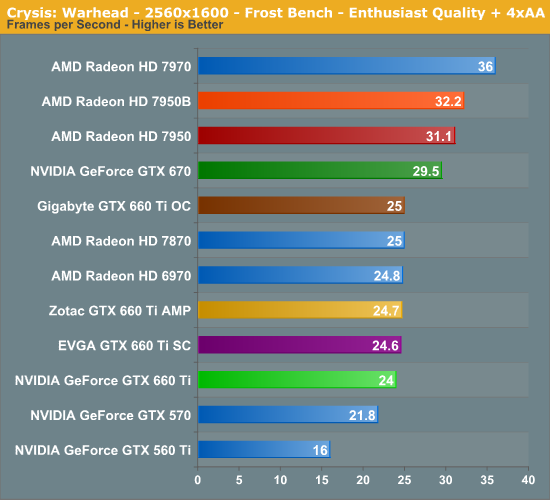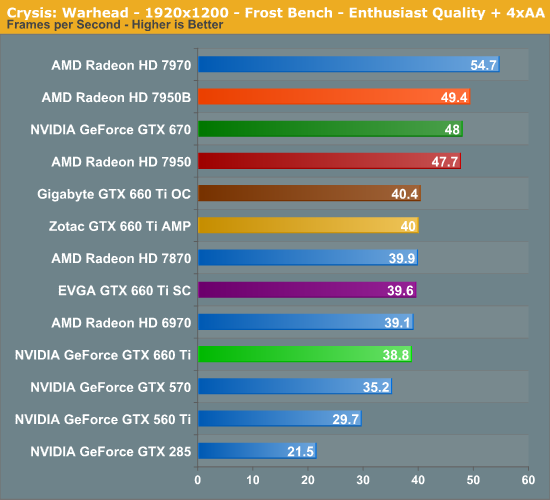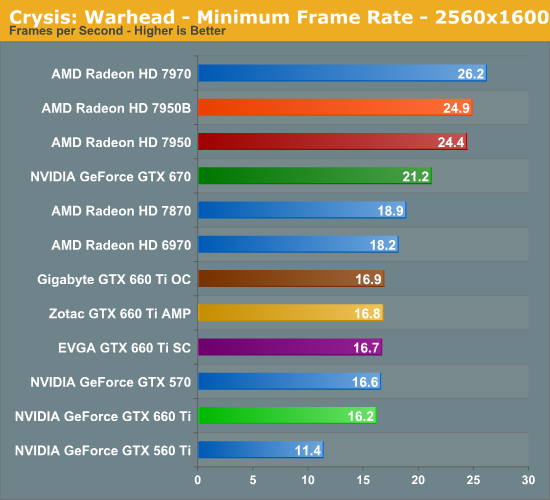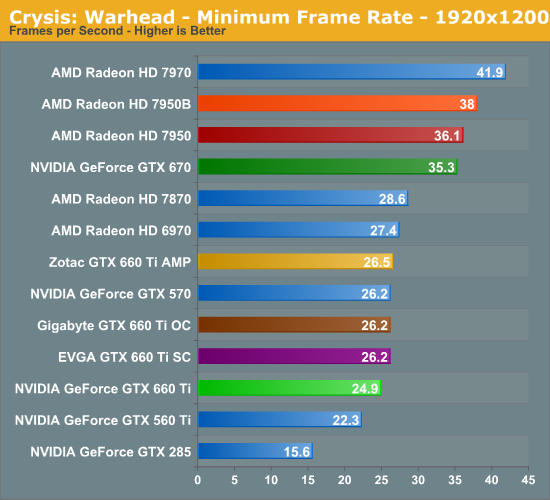The GeForce GTX 660 Ti Review, Feat. EVGA, Zotac, and Gigabyte
by Ryan Smith on August 16, 2012 9:00 AM ESTCrysis: Warhead
Kicking things off as always is Crysis: Warhead. It’s no longer the toughest game in our benchmark suite, but it’s still a technically complex game that has proven to be a very consistent benchmark. Thus even four years since the release of the original Crysis, “but can it run Crysis?” is still an important question, and the answer continues to be “no.” While we’re closer than ever, full Enthusiast settings at a 60fps is still beyond the grasp of a single-GPU card.


For a $300 performance card the most important resolution is typically going to be 1920x1080/1200, however in some cases these cards should be able to cover 2560x1440/1600 at a reasonable framerate. To that end, we’ll be focusing on 1920x1200 for the bulk of our review.
Crysis has been a sore spot for NVIDIA since the launch of Kepler, and GTX 660 Ti doesn’t improve this. Since it’s a memory bandwidth constrained game and GTX 660 Ti takes away 25% of GK104’s memory bandwidth, the result is a predictable drop in performance. The GTX 660 Ti only reaches 80% of the GTX 670’s performance here, which is only a bit more than our worst case scenario of 75%. At 38.8fps it’s playable, but it’s definitely not a great experience. So for anyone wanting to partake in this classic, an AMD card is the way to go and it doesn’t matter which; even the 7870 is marginally faster.
As for our factory overclocked cards from Zotac, EVGA, and Gigabyte, while they improve the situation they don’t do so by a great deal. Unexpectedly, despite its memory bandwidth advantage the Gigabyte card actually edges out the Zotac card here, due to the former’s higher power target allowing it to boost to higher clockspeeds. Still that’s only a 4% improvement, far below what these kinds of overclocks are really capable of hitting.


Looking at minimum framerates is even more grim; the GTX 660 Ti is experiencing its worst case scenario. Crysis, Kepler, and low memory bandwidth are a very bad combination here. As for the factory overclocked cards, the Zotac card finally takes the lead thanks to its memory overclock, but like our average framerates in Crysis it’s not a particularly big jump.










313 Comments
View All Comments
CeriseCogburn - Sunday, August 19, 2012 - link
If they can't supply it - it cannot lower competitor prices, and can't be bought, so they make little or no money, and everyone else buys the available competitors product.Why doesn't AMD release a card that drives down the 680's price $170 per card and makes nVidia give away 3 free games with it too ?
That would make too much sense for amd and we consumers and some competition that crushes evil corporate profiteering nVidia, so AMD should do it.
(roll eyes)
To answer your question> nVidia is being nice not draining all the red blood from amd's jugular since amd is bleeding out so badly already that if nVidia took them out a million raging in 3d fanboys would scream for billions in payola in a giant lawsuit they protest for in front of the UN and the IMF and the International Court and the 25k persons traveling EURO unelected power bureaucrats.
So instead of all that terribleness and making amd fans cry, nVidia is nice about it.
Galidou - Tuesday, August 21, 2012 - link
This card at 249$ would be very bad for AMD but not very good for Nvidia either. Considering how close it already is to it's bigger brother, it would probably cut a good percentage of gtx 670 sales.So yeah, 249$ might seem a good price for US but they don't want to harm themselves either.
Belard - Thursday, August 16, 2012 - link
What does TI mean?Where is the GTX 660? So its really a 670 with a hand chopped off?
ericloewe - Thursday, August 16, 2012 - link
TI means something along the lines of "We'll release a crap version later on that only OEMs will buy, called the GTX 660."Patflute - Thursday, August 16, 2012 - link
lolwutOmega215D - Thursday, August 16, 2012 - link
I think it still means "Titanium" version of a chip which was supposedly better than the non-Ti.MrSpadge - Sunday, August 19, 2012 - link
It means "We can't figure out how to distinguish our products using 3 decimal numbers and up to 3 letters in front of it (or the lack thereof), so we'll add some more letters".R3MF - Thursday, August 16, 2012 - link
in the anand review of the 450 where Nvidia first showed the lopsided memory bus arrangement it was noted that CUDA apps would not recognise the full memory complement.has this now been fixed?
Ryan Smith - Thursday, August 16, 2012 - link
Yes. That was fixed almost immediately.R3MF - Thursday, August 16, 2012 - link
thanks Ryan